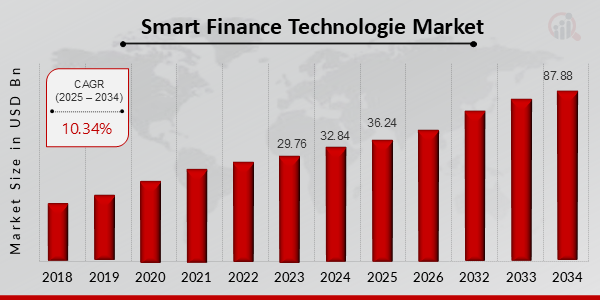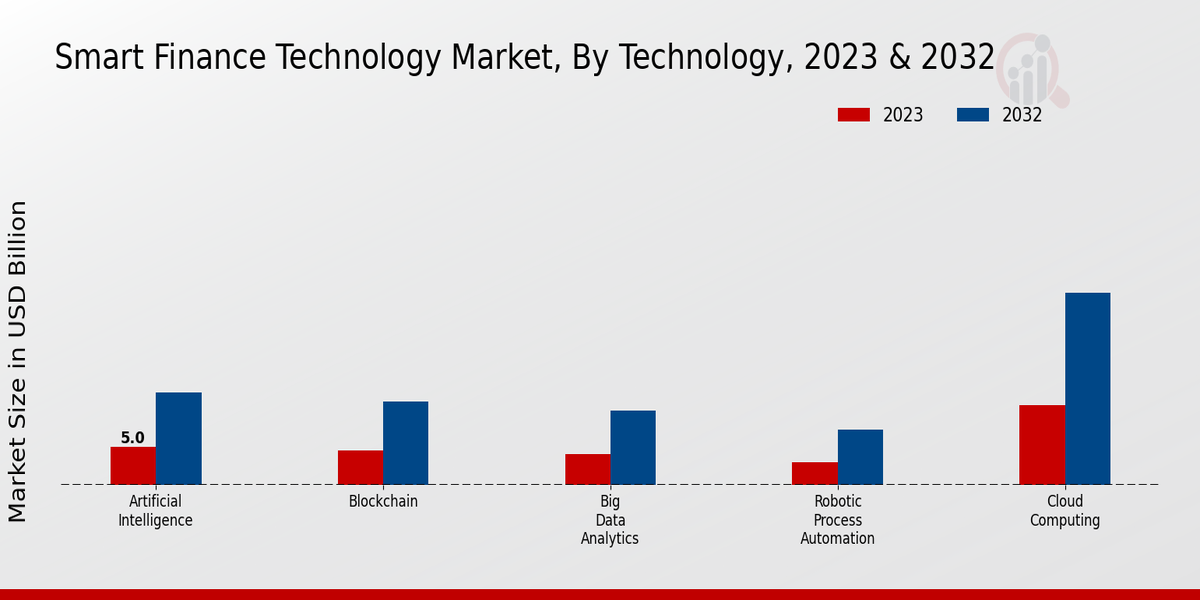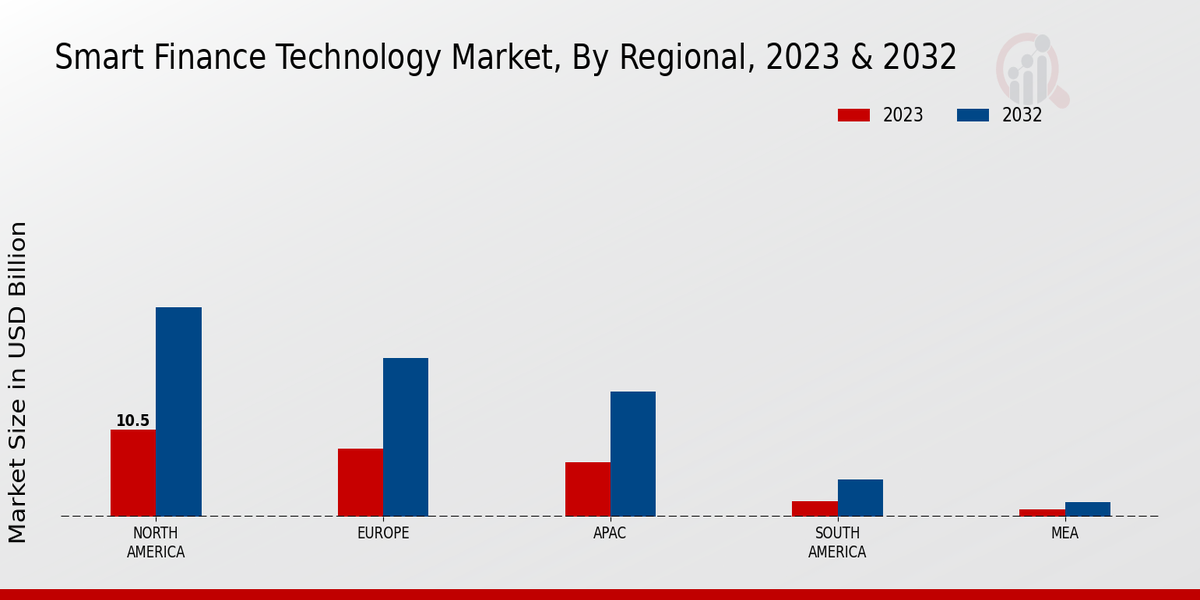Smart Finance Technology Market Overview
Smart Finance Technologie Market is projected to grow from USD 36.24 Billion in 2025 to USD 87.88 Billion by 2034, exhibiting a compound annual growth rate (CAGR) of 10.34% during the forecast period (2025 - 2034).
Additionally, the market size for Smart Finance Technologie Market was valued at USD 32.84 billion in 2024.
Key Smart Finance Technology Market Trends Highlighted
The Global Smart Finance Technology Market is experiencing significant growth, driven by the increasing demand for digitization in financial services. Consumers are now looking for personalized financial solutions, leading to the rise of fintech companies that leverage artificial intelligence and machine learning to enhance customer experiences. Additionally, the widespread adoption of mobile banking and online payment systems accelerates the need for smarter finance technology. This evolving landscape is fueled by the necessity for improved efficiency, security, and user accessibility in financial operations. Opportunities in the smart finance technology space are rapidly emerging as traditional financial institutions seek to modernize their operations.
Collaboration between fintech startups and established banks offers a promising avenue to create innovative products and services. The rising interest in blockchain technology for secure transactions further exemplifies the potential for enhancing trust and transparency in financial dealings. Furthermore, as consumers increasingly adopt digital wallets and cryptocurrency, businesses can tap into new revenue streams and expand their offerings to meet evolving demands. Recent times have seen a notable trend toward automation in financial processes, which helps reduce operational costs and increase accuracy. Consumers are becoming more comfortable with chatbots and automated advisors, indicating a shift in how financial advice is delivered.Moreover, there is an increasing emphasis on data analytics for real-time decision-making. The market is also witnessing a surge in regulatory technologies to ensure compliance with evolving financial regulations, offering firms additional tools to manage their risk effectively. As technology continues to evolve, the Global Smart Finance Technology Market will likely see further innovations that reshape the financial landscape.
Figure 1: Smart Finance Technology Market size 2025-2034

Source: Primary Research, Secondary Research, MRFR Database and Analyst Review
Smart Finance Technology Market Drivers
Increased Adoption of Digital Payment Solutions
One of the most significant drivers of growth in the Global Smart Finance Technology Market Industry is the increased adoption of digital payment solutions. As consumers and businesses alike seek convenience, speed, and security in financial transactions, the demand for digital wallets, mobile payments, and contactless transactions has surged. This trend has been further accelerated by the global shift towards cashless economies, fueled by technological advancements and changing consumer preferences.With smartphones becoming ubiquitous and internet penetration increasing, more individuals can access and utilize digital payment platforms, driving higher transaction volumes.
Additionally, businesses are also recognizing the benefits of integrating these solutions into their operations, as they streamline payment processes and improve customer experiences. The evolving landscape is not just limited to traditional payment methods but extends to innovations such as cryptocurrencies and blockchain technology, which are gaining traction in the financial sector.As the landscape continues to evolve, the competition among service providers is fierce, prompting continuous improvements and enhancements to service offerings. This, in turn, drives further adoption and investment in digital finance solutions, establishing a robust growth trajectory for the Global Smart Finance Technology Market.
Growing Demand for Advanced Financial Analytics
The Global Smart Finance Technology Market Industry is experiencing significant growth due to the increasing demand for advanced financial analytics. Businesses and financial institutions are recognizing the need for data-driven decision-making to gain a competitive edge. This has led to the adoption of sophisticated analytics tools that provide insights into customer behaviors, market trends, and operational performance. The integration of artificial intelligence and machine learning in analytics provides even deeper insights, enabling organizations to predict future financial outcomes and tailor their strategies accordingly.As organizations continue to prioritize data security and privacy, the ability to utilize secure analytics platforms becomes crucial, further driving innovation and growth in the smart finance sector.
Regulatory Compliance and Risk Management
The imperative for regulatory compliance and effective risk management is shaping the Global Smart Finance Technology Market Industry. As regulatory frameworks become increasingly stringent, financial institutions are compelled to invest in advanced technologies that ensure adherence to compliance standards. This involves the implementation of smart solutions that automate compliance processes, streamline reporting, and enhance risk assessment capabilities.As a result, organizations can minimize regulatory fines and avoid reputational damage. Moreover, the risk landscape is constantly evolving, with emerging threats such as cyber risks demanding proactive measures. Financial technology providers are stepping up to meet this demand by offering innovative products that focus on risk management and compliance, contributing to the overall growth of the market.
Smart Finance Technology Market Segment Insights
Smart Finance Technology Market Technology Insights
The Global Smart Finance Technology Market has been making remarkable strides within the Technology segment, reaching a valuation of 26.98 USD Billion in 2023, projected to grow to 65.4 USD Billion by 2032. This segment is essential as it encompasses several critical areas driving innovation and efficiency within the finance industry. Among these areas, Cloud Computing holds a significant market share, valued at 10.48 USD Billion in 2023 and anticipated to reach 25.3 USD Billion by 2032, demonstrating its dominant role in providing scalable and flexible solutions for financial institutions. Artificial Intelligence, with a valuation of 5.0 USD Billion in 2023, plays a crucial role in enhancing customer service, risk assessment, and predictive analytics, ultimately facilitating better decision-making; it is expected to grow significantly to 12.2 USD Billion by 2032, showing its increasing importance in automating processes and personalizing customer experiences.
Blockchain technology follows closely, with a valuation of 4.5 USD Billion in 2023, set to rise to 10.9 USD Billion by 2032, indicating its potential in ensuring secure transactions and improving transparency in the financial sector. This makes it a major player in combatting fraud and facilitating fast, efficient settlements. Big Data Analytics, esteemed for its capabilities in processing vast datasets, is projected to move from 4.0 USD Billion in 2023 to 9.7 USD Billion by 2032, allowing financial institutions to extract valuable insights from customer behavior and trends, thereby driving strategic decisions.
Meanwhile, Robotic Process Automation, although at a smaller valuation of 3.0 USD Billion in 2023 and expected to grow to 7.2 USD Billion by 2032, serves an essential function in automating mundane tasks and optimizing operational efficiency, showcasing its value in enhancing workforce productivity. The growth of the Global Smart Finance Technology Market is significantly propelled by increasing demand for digitization in financial services, the need for enhanced data security, and the search for innovative solutions to improve customer experiences.
However, challenges such as regulatory compliance, data privacy concerns, and rapid technological changes persist, presenting hurdles for market players. Yet, opportunities abound in harnessing innovative technology, fostering strategic partnerships, and exploring new markets. The evolving landscape in the Global Smart Finance Technology Market highlights the significance of each technological element, with Cloud Computing leading the way, followed appreciably by Artificial Intelligence and Blockchain, reflecting their growing role in shaping the future of finance. The market is brimming with potential, driven by technological advancements that promise to transform finance into a more efficient, secure, and user-friendly ecosystem.

Source: Primary Research, Secondary Research, MRFR Database and Analyst Review
Smart Finance Technology Market Application Insights
The Global Smart Finance Technology Market is poised for significant growth, with an estimated market value of 26.98 USD billion in 2023, expected to grow substantially to 65.4 USD billion by 2032. The Application segment plays a pivotal role in market dynamics, encompassing areas such as Personal Finance Management, Investment Management, Risk Management, Fraud Detection, and Lending Solutions. Personal Finance Management has gained traction due to increasing consumer awareness, while Investment Management is vital in helping investors optimize their portfolios.
Risk Management ensures organizations can mitigate financial uncertainties, which is essential in an evolving economic landscape. Fraud Detection applications are increasingly crucial as cyber threats continue to rise, highlighting the need for advanced security measures. Lending Solutions dominate the market as they facilitate quicker access to financing, meeting the demands of both consumers and businesses. The combination of these factors underscores the importance of these applications within the Global Smart Finance Technology Market, a landscape that reflects both current trends and emerging opportunities driven by technologically enhanced services and solutions.
Smart Finance Technology Market End User Insights
The Global Smart Finance Technology Market, valued at 26.98 billion USD in 2023, showcases diverse applications across the End User segment, primarily encompassing Banks, Insurance Companies, Investment Firms, Fintech Startups, and Consumer Financial Services. Banks take a significant role, utilizing smart finance technologies to enhance customer experiences and streamline operations, which fosters significant competition in the financial sector. Insurance Companies are also pivotal, as they increasingly leverage technology for risk assessment and customer service improvements, driving greater efficiency and responsiveness in their operations.
Investment Firms benefit from real-time data analytics and AI-driven insights, enabling smarter decision-making and portfolio optimization. Fintech Startups, often seen as market disruptors, introduce innovative solutions that cater to customer demands for seamless digital services, thus reshaping delivery dynamics across the finance industry. Consumer Financial Services is a vital component, as it provides personalized financial solutions, responding to the growing need for tailored consumer experiences. Collectively, these segments illustrate the expanding landscape of the Global Smart Finance Technology Market, revealing trends towards technological adoption, market growth, and evolving consumer expectations.
Smart Finance Technology Market Regional Insights
The Regional segmentation of the Global Smart Finance Technology Market showcases a diverse landscape in which North America emerges as the dominant sector, valued at 10.5 USD Billion in 2023, projected to grow to 25.1 USD Billion by 2032, indicating its majority holding in the market. Europe follows closely with a valuation of 8.2 USD Billion in 2023 and is expected to reach 19.0 USD Billion by 2032, signifying a significant presence driven by advanced technological infrastructures. Meanwhile, the APAC region, valued at 6.5 USD Billion this year and expected to grow to 15.0 USD Billion, indicates robust growth potential fueled by increasing digitalization and rising investments in fintech solutions.South America and MEA are smaller yet noteworthy segments, valued at 1.9 USD Billion and 0.9 USD Billion in 2023, respectively, with projections of 4.5 USD Billion and 1.8 USD Billion by 2032, highlighting emerging opportunities despite the comparatively lesser market share. The varied growth trajectories across these regions reflect unique challenges and opportunities, such as the need for regulatory compliance in Europe and innovation-driven expansion in APAC, impacting the overall Global Smart Finance Technology Market revenue.

Source: Primary Research, Secondary Research, MRFR Database and Analyst Review
Smart Finance Technology Market Key Players and Competitive Insights
The Global Smart Finance Technology Market is rapidly evolving, characterized by advanced technological integration, innovative financial solutions, and the growing demand for efficient service delivery. This market encompasses various segments, including digital payments, personal finance management, financial analytics, and investment technologies, all of which are designed to enhance user experience and streamline operations. The competitive landscape is defined by numerous players striving to capture market share through strategic partnerships, technological innovation, and unique service offerings. As financial institutions and service providers increasingly embrace smart technologies, the competition intensifies, resulting in a dynamic environment that fosters continual advancement and adaptation to consumer needs.Square has established a formidable presence in the Global Smart Finance Technology Market through its comprehensive payment solutions tailored for businesses of all sizes.
The company's strengths lie in its user-friendly interface, which simplifies transaction processes for merchants and customers alike. Square's innovative offerings, such as point-of-sale systems and integrated payment solutions, empower businesses by providing real-time analytics and insights, effectively aiding in decision-making. Additionally, Square has successfully built a robust ecosystem that includes additional services like payroll and invoicing, enhancing its value proposition. This multifaceted approach enables Square to cater to diverse market segments while maintaining a competitive edge through its commitment to exceptional customer service and continuous technology enhancements.SAS Institute stands out in the Global Smart Finance Technology Market with its strong emphasis on data analytics and intelligence solutions aimed at improving financial decision-making.
The company's expertise in analytics empowers financial institutions to derive insights from vast amounts of data, allowing for enhanced risk management, regulatory compliance, and customer engagement. SAS Institute's advanced analytics platforms and predictive modeling tools enable organizations to identify trends and make informed strategic decisions, thus positioning itself as an essential partner in financial technology transformation. Moreover, SAS Institute's commitment to innovation is reflected in its continuous investment in research and development, ensuring its offerings remain at the forefront of industry needs while further solidifying its reputation as a leader in financial analytics and smart technology solutions.
Key Companies in the Smart Finance Technology Market Include
-
Square
-
SAS Institute
-
Oracle
-
Visa
-
Adyen
-
PayPal
-
IBM
-
Intuit
-
NCR
-
Salesforce
-
FIS
-
Finastra
-
SAP
-
NICE Systems
-
Mastercard
Smart Finance Technology Market Industry Developments
Recent developments in the Global Smart Finance Technology Market indicate significant advancements and strategic movements by major companies. Square has been enhancing its payment processing capabilities, while SAS Institute continues to innovate in financial analytics and AI-driven solutions. Oracle is focusing on cloud-based financial services, and Visa is expanding its digital payment solutions to enhance customer experiences. Adyen and PayPal are competing fiercely in the e-commerce payment processing sector, with PayPal launching new features to streamline transactions. IBM's recent developments include advancements in blockchain technology for secure financial transactions. Intuit and Salesforce are integrating their platforms to provide improved financial management solutions for businesses.
The competitive landscape is further intensifying with NCR investing in advanced point-of-sale systems. Notable acquisitions include FIS acquiring Worldpay, which has expanded its market reach significantly. This increased activity in mergers and acquisitions is reshaping the market dynamics, pushing innovation, and enhancing overall market valuation. Companies like Finastra, SAP, and NICE Systems continue to focus on developing robust financial technologies that cater to evolving consumer needs, indicating a growing trend toward digital transformation in finance. The focus on regulatory compliance and security measures remains a critical priority across the sector.
Smart Finance Technology Market Segmentation Insights
-
Smart Finance Technology Market Technology Outlook
-
Smart Finance Technology Market Application Outlook
-
Smart Finance Technology Market End User Outlook
-
Smart Finance Technology Market Regional Outlook
-
North America
-
Europe
-
South America
-
Asia Pacific
-
Middle East and Africa
Smart Finance Technology Market Report Scope
|
Report Attribute/Metric
|
Details
|
|
Market Size 2024
|
32.84 (USD Billion)
|
|
Market Size 2025
|
36.24 (USD Billion)
|
|
Market Size 2034
|
87.88 (USD Billion)
|
|
Compound Annual Growth Rate (CAGR)
|
10.34% (2025 - 2034)
|
|
Report Coverage
|
Revenue Forecast, Competitive Landscape, Growth Factors, and Trends
|
|
Base Year
|
2024
|
|
Market Forecast Period
|
2025 - 2034
|
|
Historical Data
|
2019 - 2023
|
|
Market Forecast Units
|
USD Billion
|
| Key Companies Profiled |
Square, SAS Institute, Oracle, Visa, Adyen, PayPal, IBM, Intuit, NCR, Salesforce, FIS, Finastra, SAP, NICE Systems, Mastercard |
| Segments Covered |
Technology, Application, End User, Regional |
| Key Market Opportunities |
AI-driven financial analytics, Blockchain for secure transactions, Robo-advisors for personalized investing, Mobile payment solutions growth, Integration of IoT in finance |
| Key Market Dynamics |
Digital transformation adoption, Increasing investment in fintech, Regulatory compliance challenges, Rising demand for personalized services, Data security and privacy concerns |
| Countries Covered |
North America, Europe, APAC, South America, MEA |
Frequently Asked Questions (FAQ) :
The Global Smart Finance Technology Market is expected to be valued at approximately 87.88 USD Billion by the year 2034
The market is projected to grow at a CAGR of 10.34% from 2025 to 2034
North America is expected to dominate the market with an estimated value of 25.1 USD Billion by the year 2032.
Artificial Intelligence is expected to reach a market value of 12.2 USD Billion in 2032.
Major players in the market include Square, Oracle, Visa, PayPal, and IBM.
Cloud Computing is projected to reach a market value of approximately 25.3 USD Billion by 2032.
The Blockchain segment is anticipated to grow to a market value of 10.9 USD Billion by 2032.
The APAC region is expected to achieve a market size of approximately 15.0 USD Billion by 2032.
Robotic Process Automation is estimated to be valued at 7.2 USD Billion by 2032.
Key growth drivers include advancements in technology and increasing demand for automation in financial processes.

















